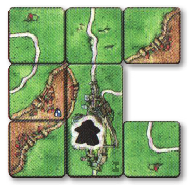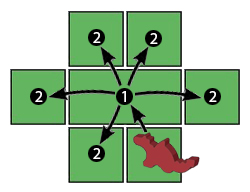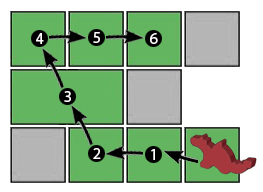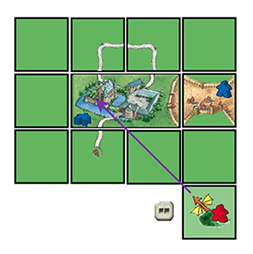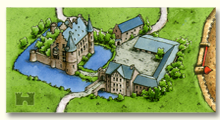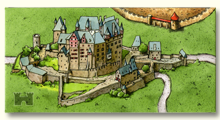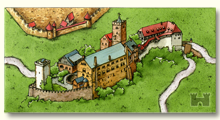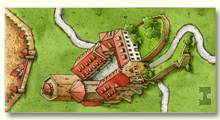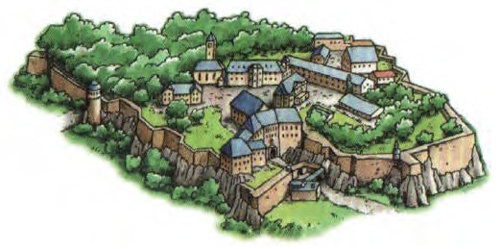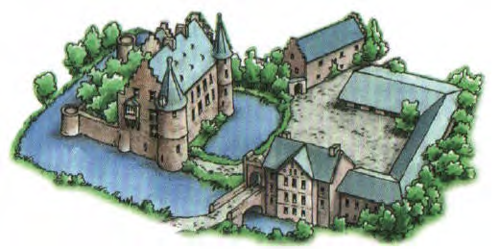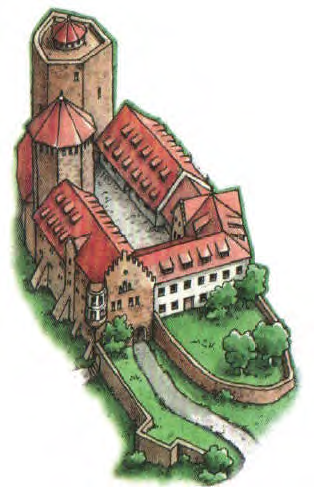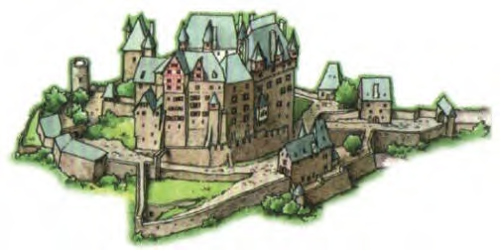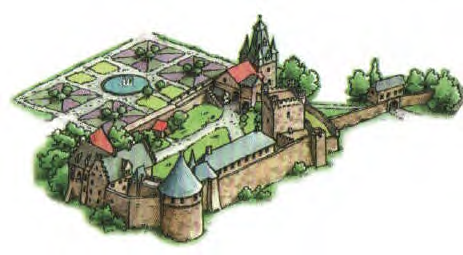Castles in Germany (1st edition)
 |
You are reading the rules for this tile design. |
 | Read the following rules if your tiles look like this. |
| If your tiles have a different design, then choose a game from Spin-offs. |  |
General info and comments
Castles in Germany (Burgen in Deutschland) was originally released by Hans im Glück in 2015. The rules show another expansion symbol than the tiles. It is assumed that this was changed at the last minute and forgotten in the rules or vice versa. The castles in Germany of the second edition show the same symbol as shown in the rules of the first edition.
This mini-expansion, featuring 6 well-known castles in Germany, allows the players to become lords and ladies, earning extra points for their famous estates.
Contents
- 6 double-size landscape tiles depicting German castles
Rules
Preparation
Each player takes 1 Castle of their choice. (With 2 or 3 players, each player may take 2 Castles.) Alternatively, mix the Castle tiles and distribute them randomly. Players then place their Castle(s) face up in front of them. [1] This expansion is designed for the basic Carcassonne game, and with the exception of the new rules shown below, all basic Carcassonne rules remain unchanged.
Placing a tile
During their turn, a player may place one of their castle tiles instead of drawing a normal tile. A castle tile may not touch any other previously placed castle tiles, either orthogonally or corner-to-corner (diagonally). The other usual rules for placement of landscape tiles still apply.
Deploying a follower
After placing a castle tile, the player may place one of his or her followers to the tile as usual. The follower may be placed on a road, city, or field, following the usual deployment rules. If the follower is deployed to the castle itself, it becomes a lord or lady of the castle.
Scoring
Scoring a castle
A castle is considered to be completed when the tile is completely surrounded by tiles, in the same manner as a cloister, and is scored in the same way. Once a castle is completed, the player with a lord/lady on the castle receives 12 points, and the player returns his or her follower into his or her supply as usual. At the end of the game, each tile surrounding an unfinished castle scores 1 point for the castle, and the castle tile itself scores 2 points.
Scoring completed roads and cities around the castle [2] [3]
If a road or a city that ends (and/or starts) on a castle tile is completed, all players with a majority of followers on the completed road or city score(s) 3 bonus points per involved castle.[4] [5] It does not matter whether the castles are occupied or not.
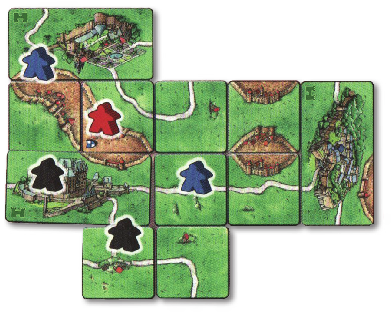
- BLACK places the castle tile at lower left and deploys a follower to the castle. Placing this tile completes 2 roads and 1 city.
- RED and BLUE each receive 16 points for the completed city (10 points for the city itself, and 2x3 points for the 2 castles).
- BLACK receives 5 points for his completed road (2 points for the road itself, and 3 points for the castle).
- BLUE receives 10 points for his completed road (4 points for the road itself, and 2x3 points for the 2 castles).
Other expansions
>> General considerations
- This section covers clarifications regarding the interaction of German castles with other expansions (from 10/2015)
>> Inns and Cathedrals - Bonus Points
- Scoring first takes place for roads with an inn or a city with a cathedral, and then the +3 bonus from any German castle is added.
>> The Princess and The Dragon - Dragon movement
- German castles do not protect followers from the dragon. The German castle is on one tile, so it has less functions than a castle (from Bridges, Castles and Bazaars) that sits between 2 tiles. The function or the mechanics of the German castle is more like those of a cloister.
- The German castle tile is one single tile - so the dragon needs only one of his 6 moves for this tile and then continues on its way.
>> The Tower - Tower range
- German castles count as one tile for the tower range.
>> Abbey and the Mayor - Part 1: Wagon movement
- The wagon can be placed on a German castle.
- The wagon can be driven to a German castle after completing a road that is connected to the German castle - as long as the German castle is not finished and no other follower owns it.
>> Abbey and the Mayor - Part 2: Barn Placement
- The general rule states that the base for the barn has to be stable - that means that the corner of all four tiles have to touch each other and all tiles must have field in the corner for the placement of the barn.
- A German castle tile can therefore occupy one or two of the corners under the barn
>> The Flier (Flying Machines) - Flier distance and placement
- The German castle counts as 1 tile. If the flier lands on this tile then the flier has the choice of 3 roads, 1 city or the German Castle (the function or the mechanics of the German Castle is more like those of a cloister). The flier can only land on one of these features if it is not yet finished.
- If the flight of the flier is diagonal, all steps must be in a straight line in the direction the arrow shows from the flying machine tile. The angle cannot change but it would if it had entered via one corner of the German castle tile, and exited via the opposite corner. If the flier lands on the German castle tile then the flier has the choice of 3 roads, 1 city or the German Castle. The flier can only land on one of these features if it is not yet finished.
>> The Plague - Plague spreading
- A German castle counts as 1 tile for the plague tokens.
>> German/Dutch and Belgian Monasteries - Abbot scoring
- There is no explicit clarification on how German castles affect the scoring of the abbot on a Monastery. It seems reasonable to apply the principles provided for The Tower above.
>> The Watchtowers - Scoring
- A watchtower scoring for roads or cities will consider all the features on a double-sized tile, even if one of their halves is not actually adjacent.
- A watchtower scoring for meeples will consider all the meeples on double-sized tiles adjacent to them, even if one of their halves is not actually adjacent.
![]() Question: If a watchtower scoring for meeples is adjacent to only one half of a double-sized tile, does the watchtower consider those meeples on the half adjacent to the watchtower or all the meeples on the tile?
Question: If a watchtower scoring for meeples is adjacent to only one half of a double-sized tile, does the watchtower consider those meeples on the half adjacent to the watchtower or all the meeples on the tile?
Answer: The watchtower will consider all the meeples on the double-sized tile. (10/2022)
Tile distribution
The castles in detail
Königstein Fortress (Saxony)
This is one of the largest mountain fortresses in Europe. It lies in the Saxon Switzerland amid the Elbe Sandstone Mountains, near Dresden. It was built on a plateau rising 240 meters above the Elbe. Spanning over 750 years of history, these fortifications are comprised of an impressive ensemble of buildings in late Gothic, Renaissance, Baroque, and 19th century construction styles. Since 2008, an annual Carcassonne fan meeting has been held at the Fortress each February. http://www.festung-koenigstein.de
Konradsheim Castle (NRW)
This moated castle is located between Cologne and Bonn and is one of the few surviving late medieval castles in the Rhineland. It was first mentioned in documents dating back to 1337. Knight Arnold of Bushveld is regarded as its builder. Today the castle is privately owned and can be rented for events. Since 2012, an annual Carcassonne fan meeting has been held here each November. http://www.burg-konradsheim.de
Rieneck Castle (Bayern)
Built around 1150, Rieneck Castle is located in the Lower Franconian Sinntal in Bavaria. Today, it is the Youth Castle of the Association of Christian Scouts and Guides. A particularly well-known part of the structure, and regarded as the heart of the castle, is the "Thick Tower." Built in the 12th century with a historically unique Romanesque chapel wall, it is completely enclosed by the wall of the keep. http://www.burg-rieneck.de
Eltz Castle (Eifel / Rhineland-Pfalz)
This is considered the epitome of a German knights castle. It is located in the Elz Valley on the edge of the Eifel mountain range. Built at the beginning of the 12th century, it has withstood the test of time. Its history is rich with myths and events, important personalities, and great art. http://www.burg-eltz.de
Wartburg Castle (Thuringia)
Wartburg Castle overlooks the town of Eisenach in Thuringia. It was founded in 1067 by Louis Springer, and since 1999 it has been a UNESCO World Heritage Site. From May 1521 to March 1522, the controversial reformer Martin Luther found refuge at Wartburg while translating the New Testament into German. http://www.burg-rieneck.de
Bentheim Castle (Lower Saxony)
This is an early medieval castle surrounded by the city of Bad Bentheim in Lower Saxony. It is considered one of the largest and most beautiful castles in northwest Germany. The earliest records of this castle date back to the 11th century. Today, the castle houses a museum and can be visited year-round. http://www.burg-bentheim.de
Footnotes
For Icons explanation and licensing please visit Icons page.
- ↑
 The rules do not mention that the Castle tiles are kept face down, so they have to remain visible once distributed and placed in front of the players.
The rules do not mention that the Castle tiles are kept face down, so they have to remain visible once distributed and placed in front of the players.
Note: The new edition rules in German make this point clear. - ↑
 Question: How many points does a German castle count for cloister scoring? Answer: A German castle tile is one tile and counts as one tile for scoring a cloister. (10/2015)
Question: How many points does a German castle count for cloister scoring? Answer: A German castle tile is one tile and counts as one tile for scoring a cloister. (10/2015)
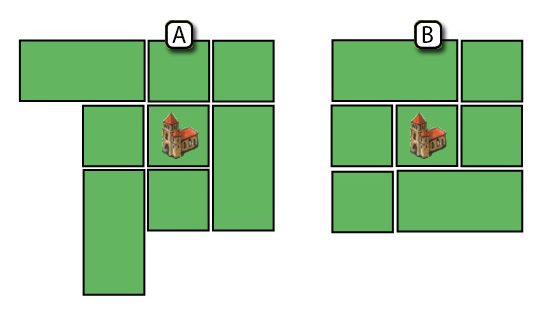 Examples of cloister scoring with German castles. The player gets 1 point for the cloister tile and 1 point per tile around it:
Examples of cloister scoring with German castles. The player gets 1 point for the cloister tile and 1 point per tile around it:- Example A: This completed cloister scores 8 points, with 3 German castles in its vicinity.
- Example B: This completed cloister scores 7 points, with 2 German castles in its vicinity.
- ↑
 Question: Does a German castle count for farm scoring? Answer: No, it doesn't count for farm scoring. The German castle is on one tile, so its has less functions than a castle that sits between two tiles. (10/2015)
Question: Does a German castle count for farm scoring? Answer: No, it doesn't count for farm scoring. The German castle is on one tile, so its has less functions than a castle that sits between two tiles. (10/2015)
- ↑
 Thus, a road that had each end on a different castle tile would score 6 bonus points. A road that began and ended on the same castle tile would receive 3 bonus points. (4/2015)
Thus, a road that had each end on a different castle tile would score 6 bonus points. A road that began and ended on the same castle tile would receive 3 bonus points. (4/2015)
- ↑
 These bonus points are added to the feature score after modifications from inns or cathedrals. (10/2015)
These bonus points are added to the feature score after modifications from inns or cathedrals. (10/2015)



